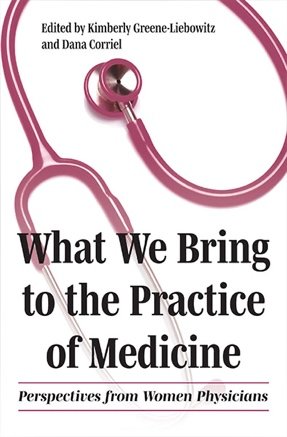In 1960, women comprised 6.7% of practicing physicians; today, that number is 37%. Women often face different difficulties from their male counterparts; even today, misogyny, discrimination and societal expectations affect training, health, specialty selection and academic progress.
In What We Bring to the Practice of Medicine, a collection of essays published by Kent State University Press and edited by Kimberly Greene-Liebowitz and Dana Corriel, women who are clinicians share stories from their careers that altered how they saw themselves and their patients. These authors have no fear of vulnerability; they recognize their emotional responses as not only acceptable, but necessary for them to be the physician they want to be.
The book is divided into eight sections featuring essays grouped by theme, so one can easily read them separately or together. Within each section, the essays are diverse in topic and feature voices from different backgrounds. Each has a strong and unique voice, the voice of women physicians as they change the practice of medicine from detachment to connection.
In “The First to Report,” Kimberly Greene-Liebowitz relates the story of an attempted rape as a medical student by an intern, who reported the injuries he incurred as she fought him and named her as the attacker. The reaction of her attending– reprimand–shocked her. She says, “The weight of blame had fallen entirely upon my head,” and details the short and long-term effects on her career.
Rachel Kowalsky explores in “Halloween Blood” how an interaction about the composition of fake blood became absurd yet showed the importance of humility. “Wouldn’t it be good,” she says, “if I could know the answer?”
As actions without compassion spread across our country, Rebecca Andrews’s brilliant essay “Chrysalis” illuminates how love and acceptance of her trans child bring them both to a place of happiness. “So, today, I say goodbye to my daughter forever. Today, I say hello to my son.”
In “The Secret Keeper,” Dawn Harris Sherling relates how a patient shared her deepest loss and shame with her, then slipped into dementia, leaving the author the only one to know the story.
“Sometimes, I Help People Die” by Kimberly Greene-Liebowitz is just one of the heartfelt ruminations on a good death in the section “Sadness and Grief.” She says, "I had come to realize that sometimes the physician's goal should be to help people die."
In “Sometimes Doctor Mom Is Just Mom,” Jasmine R. Marcelin describes how she lost all awareness of her doctor persona when her son was injured. “In a moment when my child was hurting, all I could ever be was ‘Mom.’ And that’s OK.”
“Pink Panties” by Elisabeth Preston-Hsu is a gem. A patient’s attitude towards orthopedic rehab shows the author a new way to deal with the stress of a new baby.
Some essays in this collection are of lesser quality and lead to unevenness in several sections, but overall this was well done. Women in the clinical world live the stories told in What We Bring to the Practice of Medicine; they may be surprising and moving to other readers.—Maureen Hirthler
Maureen Hirthler is a retired physician who holds an MFA in Creative Writing from the University of Missouri-Kansas City. She is the Managing Editor of Intima: A Journal of Narrative Medicine. Her writing has been published in Creative Nonfiction, the International Journal of Whole PersonCare, the Examined Life Journal and others. She resides in Florida with her husband and very sweet dogs.


